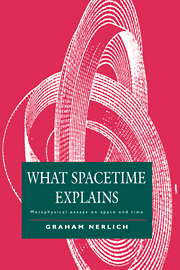Book contents
- Frontmatter
- Contents
- Preface
- Introduction
- Part One Ontology and methodology in relativity
- 1 On Learning from the mistakes of Positivists
- 2 What ontology can be about with Andrew Westwell-Roper
- 3 Special Relativity is not based on causality
- 4 Simultaneity and convention in Special Relativity
- 5 Motion and change of distance
- Part Two Variable curvature and General Relativity
- Part Three Time and causation
- Bibliography
- Index
5 - Motion and change of distance
Published online by Cambridge University Press: 19 October 2009
- Frontmatter
- Contents
- Preface
- Introduction
- Part One Ontology and methodology in relativity
- 1 On Learning from the mistakes of Positivists
- 2 What ontology can be about with Andrew Westwell-Roper
- 3 Special Relativity is not based on causality
- 4 Simultaneity and convention in Special Relativity
- 5 Motion and change of distance
- Part Two Variable curvature and General Relativity
- Part Three Time and causation
- Bibliography
- Index
Summary
Introduction
Sometimes things move; sometimes they stay in the same place. These are old, simple and primitive thoughts. Even so, they pervade the most subtle and sophisticated modern physical theories. I will discuss the impact of relativity theory on these old simple ideas. I hope to highlight some simple, basic presuppositions in classical thinking about rest and motion that have turned out false and which are still widely thought to be obvious. I have to say a little about coordinate systems for spacetimes or frames of reference corresponding to them. But I look at them only to draw some lessons that might be applied to the older, simpler ideas. I try to give a rational reconstruction of our simplest ideas of rest and motion; so I offer speculation rather than proof. Though I am guessing, I hope the guess is educated enough to shed some light and hold some interest.
I shall begin with John Locke, an author whose thought has much influenced C. B. Martin. Martin taught me to admire Locke and his virtues of realism, or rather, perhaps, of ontic seriousness. If this paper succeeds it will have something of those virtues and reflect Charlie Martin's benign influence, as so much of the writing of his students does. Neither Locke nor Martin has an extensive theory of motion, but Locke has such sensible things to say about it, even though what he said has turned out false. And there was no way Locke could have foreseen this.
- Type
- Chapter
- Information
- What Spacetime ExplainsMetaphysical Essays on Space and Time, pp. 119 - 140Publisher: Cambridge University PressPrint publication year: 1994

